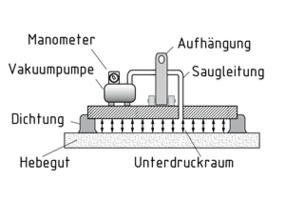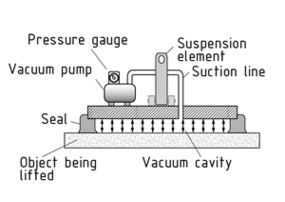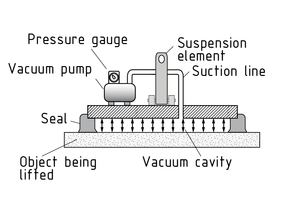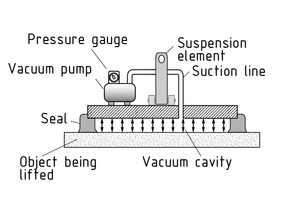
Wählen Sie eine
oder mehrere Sprachen aus
0,1,0
- Deutsch
- Englisch
- Chinesisch
- Spanisch
Vakuumheber

Vakuumheber gehören zu den Lastaufnahmemitteln. Sie werden vor allem dort eingesetzt, wo Lasten mit glatten und wenig porösen Flächen bewegt werden müssen, beispielsweise Blech-, Glas- oder Spanplatten. Vakuumheber werden an Elektroseilzügen oder Kettenzügen befestigt.
Bei einem Vakuumheber wird Unterdruck in einem Raum zwischen Tragmittel und Last erzeugt, der gegenüber dem atmosphärischen Druck nach außen mit Gummi abgedichtet ist. Dazu wird eine Vakuumpumpe verwendet.
Vakuumheber werden für den waagerechten Transport von Lasten bis zu rund 50 Tonnen eingesetzt. Etwa um die Hälfte eingeschränkt ist ihre Tragfähigkeit bei senkrecht stehender Angriffsfläche.
Mehrteilige Vakuumheber werden bei sehr großen Lastflächen genutzt. Dabei können mehrere Saugelemente an einer Lasttraverse hängen, die mit einer gemeinsamen Pumpe versorgt werden. Wird ein Vakuumspeicher verwendet, kann die Pumpe für kürzere Taktzeiten kontinuierlich betrieben werden.
Vacuum lifter

A vacuum lifter is a type of load-handling attachment. It is used primarily when moving goods with smooth and largely non-porous surfaces, such as panels made of sheet metal, Glass and chipboard. Vacuum lifters are attached to electric Cable hoists and Chain hoists.
A vacuum pump generates underpressure between the load-handling attachment and the load, while a rubber Seal protects the vacuum from the surrounding atmospheric pressure.
When attached to a horizontal surface, vacuum lifters can transport loads weighing up to around 50 metric tons. When the contact surface is vertical the load-Bearing capacity is approximately half.
When transporting goods with very large surface areas, multi-part vacuum lifters are used that have numerous suction elements suspended from a spreader bar and operated by a single pump. If a vacuum accumulator is used, the pump can be run continuously for shorter cycle times.
真空提升机

真空提升机也是一种物料搬运工装。它主要用于提升具有光滑和大部分表面无孔的货物,如金属板制成的板,玻璃板和再生纸板。真空提升机一般会和电缆索葫芦或链条葫芦连接到一起。
真空泵在物料搬运工装和负载之间产生负压,而橡胶密封避免真空环境接触周围的大气压力。
当连接到一个水平面时,真空提升机提升载荷重可达 50 吨左右。如果接触面是垂直的,承载能力就只有一半左右。
当提升的货物具有非常大的表面积时,分体式真空提升机就可以大显身手。它有许多悬挂在撑杆上的吸气元件,统一连接到一个泵。如果使用真空蓄能器的话,该泵可以以更短的运转周期连续运行。
真空提升机
Elevador por vacío

Un elevador por vacío es un tipo de aditamento de manejo de carga. Se usa principalmente cuando se mueven artículos con superficies suaves y principalmente no porosas, como los paneles hechos de láminas de metal, vidrio y aglomerado. Los elevadores por vacío se sujetan a polipastos de cable eléctricos y a polipastos de cadena.
Una bomba de vacío genera una baja presión entre el aditamento de manejo de carga y la carga, mientras que un sello de hule protege el vacío de la presión atmosférica circundante.
Cuando se sujetan a una superficie horizontal, los elevadores por vacío pueden transportar cargas que pesen hasta alrededor de 50 toneladas. Cuando la superficie de contacto es vertical, la capacidad de carga se reduce a aproximadamente la mitad.
Cuando se transportan artículos con áreas de superficie muy grandes, se usan elevadores por vacío de partes múltiples que cuentan con numerosos elementos de succión suspendidos a partir de una barra separadora y operados por una bomba única. Si se usa un acumulador de vacío, la bomba puede funcionar continuamente para tiempos de ciclo más cortos.
Elevador por vacío
